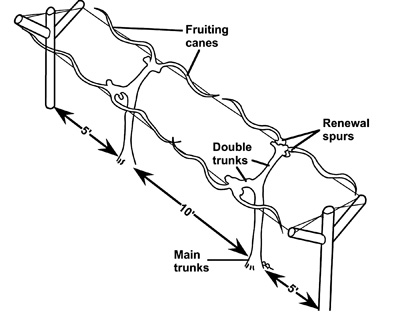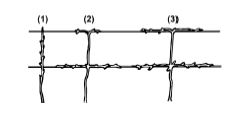From
the University of Georgia Cooperative Extension
College of Agriculture and Environmental Sciences
Training Young Vines
Excerpts from the Home Garden Bunch Grapes publication
First Year
— Regardless
of the training system to be followed, your goal is the development and
establishment of a well developed root system. It is recommended that
after planting, the strongest cane be cut back to two or three strong
buds. Remove any other canes present. Because it is sometimes difficult
to determine the condition of a dormant vine, however, some growers
prefer to leave five to six buds and then, when growth starts, only
allow the most vigorous or desirable buds to develop into shoots. These
shoots will be trained to form trunks and cordons, the permanent woody
tissues of a grapevine.
If
the trellis cannot be constructed the first growing season, then a
stake 4 to 5 feet high should be driven in the soil near each vine and
the new growth trained to it. Although bamboo can work, it is often
unable to stay erect without the support of a wire. Thus, stakes made
of stronger materials, such as steel, may be desirable if a trellis is
not constructed at the time of planting. Tie the shoots loosely,
or with plastic
tape, to avoid the possibility of girdling. In cool areas of the
country, growth rates are slow and vines are often pruned back to near
ground level the first winter to help develop a vigorous trunk the
second year. In Georgia the growing season is long and vines often make
impressive growth the first year. While many may opt for training only
one trunk, training two trunks provides insurance in case on trunk is
subject to mechanical or cold injury.
Double Curtain Trellis
— Develop a double trunk (Y shape) for each vine approximately 30
inches above the ground. This is done by pinching out the growing point
and forcing two lateral shoots to develop. One trunk should be allowed
to grow
to one of the trellis wires and the other trunk to the other wire. Just
below the wire, pinch out the tip of the growing shoots to encourage
lateral formation and growth. These lateral shoots will be trained to
the catch wires to serve as fruiting cordons. Under good conditions,
the trunk system for the grape
vine should be developed by the end of the first growing season.
Two Wire Vertical Trellis
— Develop a single strong shoot arising from the young plant by
removing competing shoots. Train this shoot to a string or stake
running from the upper wire of the trellis to the ground. Just below
each wire pinch out the tip to encourage two lateral shoots to develop.
These lateral shoots will be used to train the vine horizontally onto
the fruiting wire.
Single Wire Trellis High Trellis and Single Wire Low Trellis with Catch Wires
— One shoot should be allowed to develop into the trunk. Train
the trunk to a string or a training stake. When the tip reaches the
wire, pinch it out and select two shoots growing about eight inches
below the wire. Shoots positioned to grow on the trellis wire should be
allowed to grow 12 to 18 inches long before they are tied down to the
wires. Never tie the growing shoot tips to the wire because they will
lose vigor. Always leave at least 6 inches of shoot tip free beyond the
last tie so it can grow in an upward direction to maintain vigor.
Second Year
— The second year should be devoted to training and developing a
strong plant structure that can support some fruiting during the third
season. Fig. 1 illustrates vines properly trained to the double curtain
trellis, while Fig. 2 illustrates pruning and training to the two wire
vertical trellis (Kniffin system).
 |
Fig.
1
The double curtain trellis showing double trunks, fruiting canes and
renewal spurs after pruning |
 | Fig. 2
Training
the young vine to the two-wire vertical trellis (four arm Kniffin
system). 1) Pruning after 1 year's growth, 2) after 2 years' growth, 3)
after 3 years' growth |
Assuming
normal growth has been obtained during the first growing season, all
buds on the trunk remaining after pruning are capable of developing
into shoots and producing fruit. Fruit production at this stage of vine
development will reduce vegetative growth and, therefore, is not
desirable. Removal of flower clusters when they occur is recommended.
All shoots below the bottom trellis wire should be removed, including
suckers from the base of the vine. Continue to develop the permanent
cordons (arms). Pinch off developing flowers unless the vines have made
tremendous growth the first year. Even then, leave no more than a
cluster or two of fruit. Remember that your goal is training, not fruit
production.
Further Reading
Home Garden Bunch Grapes, Georgia University, Cooperative Extension pdf
Grape Trellis Systems, University of Georgia, Cooperative Extension
Pruning the Bearing Vine, University of Georgia, Cooperative Extension
Back to
Bunch Grape Page
Pruning and Training Page
|
|
Bibliography
Krewer, Gerard. "Home Garden Bunch Grapes." University
of Georgia, Cooperative Extension,
Published with Major Revisions on Oct 15, 2006, Minor Revisions on Jan
05, 2010, Full Review on Jan 01, 2014, Minor Revisions on Jun 13, 2017,
extension.uga.edu/publications/detail.html?number=B807&title=Home%20Garden%20Bunch%20Grapes. Accessed 10 Oct. 2018.
Published 7 Nov. 2014 LR. Last update 10 Oct. 2018 LR
|
